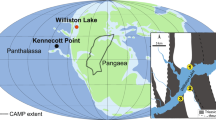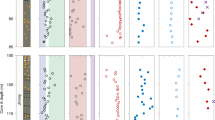Abstract
All known forms of life require phosphorus, and biological processes strongly influence the global phosphorus cycle1. Although the record of life on Earth extends back to 3.8 billion years ago2 and the advent of biological phosphate processing can be tracked to at least 3.5 billion years ago3, the earliest known P-rich deposits appeared only 2 billion years ago4,5. The onset of P deposition has been attributed to the rise of atmospheric oxygen 2.4–2.3 billion years ago and the related profound biogeochemical shifts6,7,8,9, which increased the riverine input of phosphate to the ocean and boosted biological productivity and phosphogenesis5,10. However, the P-rich deposits post-date the rise of oxygen by about 300 million years. Here we use microfabric, trace element and carbon isotope analyses to assess the environmental setting and redox conditions of the 2-billion-year-old P-rich deposits of the vent- or seep-influenced Zaonega Formation, northwest Russia. We identify phosphatized microorganism fossils that resemble modern methanotrophic archaea and sulphur-oxidizing bacteria, analogous to organisms found in modern seep settings and upwelling zones with a sharp redoxcline11,12. We therefore propose that the P-rich deposits in the Zaonega Formation were formed by phosphogenesis mediated by sulphur bacteria, similar to modern sites13, and by the precipitation of calcium phosphate minerals on microbial templates during early diagenesis.
This is a preview of subscription content, access via your institution
Access options
Subscribe to this journal
Receive 12 print issues and online access
$259.00 per year
only $21.58 per issue
Buy this article
- Purchase on Springer Link
- Instant access to full article PDF
Prices may be subject to local taxes which are calculated during checkout





Similar content being viewed by others
References
Follmi, K. B. The phosphorus cycle, phosphogenesis and marine phosphate-rich deposits. Earth-Sci. Rev. 40, 55–124 (1996).
Rosing, M. T. C-13-depleted carbon microparticles in >3700-Ma sea-floor sedimentary rocks from west Greenland. Science 283, 674–676 (1999).
Blake, R. E., Chang, S. J. & Lepland, A. Phosphate oxygen isotopic evidence for a temperate and biologically active Archaean ocean. Nature 464, 1029–1039 (2010).
Melezhik, V. A. et al. Emergence of the modern earth system during the archean-proterozoic transition. GSA Today 15, 4–11 (2005).
Papineau, D. Global biogeochemical changes at both ends of the Proterozoic: Insights from phosphorites. Astrobiology 10, 165–181 (2010).
Holland, H. D. The oxygenation of the atmosphere and oceans. Phil. Trans. R. Soc. B 361, 903–915 (2006).
Reuschel, M. et al. Isotopic evidence for a sizeable seawater sulfate reservoir at 2.1 Ga. Precambrian Res. 192–195, 78–88 (2012).
Karhu, J. A. & Holland, H. D. Carbon isotopes and the rise of atmospheric oxygen. Geology 24, 867–870 (1996).
Kump, L. R. et al. Isotopic evidence for massive oxidation of organic matter following the great oxidation event. Science 334, 1694–1696 (2011).
Bekker, A. & Holland, H. D. Oxygen overshoot and recovery during the early Paleoproterozoic. Earth Planet. Sci. Lett. 317, 295–304 (2012).
Schulz, H. N. et al. Dense populations of a giant sulfur bacterium in Namibian shelf sediments. Science 284, 493–495 (1999).
Kalanetra, K. M., Joye, S. B., Sunseri, N. R. & Nelson, D. C. Novel vacuolate sulfur bacteria from the Gulf of Mexico reproduce by reductive division in three dimensions. Environ. Microbiol. 7, 1451–1460 (2005).
Schulz, H. N. & Schulz, H. D. Large sulfur bacteria and the formation of phosphorite. Science 307, 416–418 (2005).
Williams, L. A. & Reimers, C. Role of bacterial mats in oxygen-deficient marine basins and coastal upwelling regimes: Preliminary report. Geology 11, 267–269 (1983).
Goldhammer, T., Bruchert, V., Ferdelman, T. G. & Zabel, M. Microbial sequestration of phosphorus in anoxic upwelling sediments. Nature Geosci. 3, 557–561 (2010).
Benzerara, K. et al. Biologically controlled precipitation of calcium phosphate by Ramlibacter tataouinensis. Earth Planet. Sci. Lett. 228, 439–449 (2004).
Puchtel, I. S., Brugmann, G. E. & Hofmann, A. W. Precise Re-Os mineral isochron and Pb-Nd-Os isotope systematics of a mafic-ultramafic sill in the 2.0 Ga Onega plateau (Baltic Shield). Earth Planet. Sci. Lett. 170, 447–461 (1999).
Melezhik, V. A., Huhma, H., Condon, D. J., Fallick, A. E. & Whitehouse, M. J. Temporal constraints on the Paleoproterozoic Lomagundi-Jatuli carbon isotopic event. Geology 35, 655–658 (2007).
Qu, Y., Crne, A. E., Lepland, A. & Van Zuilen, M. A. Methanotrophy in a Paleoproterozoic oil field ecosystem, Zaonega Formation, Karelia, Russia. Geobiology 10, 467–478 (2012).
Asael, D. et al. Coupled molybdenum, iron and uranium stable isotopes as oceanic paleoredox proxies during the Paleoproterozoic Shunga Event. Chem. Geol.http://dx.doi.org/10.1016/j.chemgeo.2013.08.003 (2013).
Anbar, A. D. et al. A whiff of oxygen before the Great Oxidation Event? Science 317, 1903–1906 (2007).
Van Zuilen, M. A. et al. Mineral-templated growth of natural graphite films. Geochim. Cosmochim. Acta 83, 252–262 (2012).
Rozanov, A. Y., Astafieva, M. M. & Hoover, R. B. in Proc. SPIE Instruments, Methods, and Missions for Astrobiology X Vol. 6694 (eds Hoover, R. B., Levin, G. V., Rozanov, A. Y. & Davies, P. C. W.) 669409 (SPIE, 2007).
Krajewski, K. P. et al. Biological processes and apatite formation in sedimentary environments. Eclogae. Geologicae. Helvetiae. 87, 701–745 (1994).
Sanchez-Navas, A. & Martin-Algarra, A. Genesis of apatite in phosphate stromatolites. Eur. J. Mineral. 13, 361–376 (2001).
Knittel, K., Losekann, T., Boetius, A., Kort, R. & Amann, R. Diversity and distribution of methanotrophic archaea at cold seeps. Appl. Environ. Microbiol. 71, 467–479 (2005).
Bailey, J. V., Joye, S. B., Kalanetra, K. M., Flood, B. E. & Corsetti, F. A. Evidence of giant sulphur bacteria in Neoproterozoic phosphorites. Nature 445, 198–201 (2007).
Xiao, S. H., Hagadorn, J. W., Zhou, C. M. & Yuan, X. L. Rare helical spheroidal fossils from the Doushantuo Lagerstatte: Ediacaran animal embryos come of age? Geology 35, 115–118 (2007).
Cunningham, J. A. et al. Distinguishing geology from biology in the Ediacaran Doushantuo biota relaxes constraints on the timing of the origin of bilaterians. Proc. R. Soc. B 279, 2369–2376 (2012).
Fallick, A. E., Melezhik, V. A. & Simonson, B. M. in Biosphere Origin and Evolution (eds Dobretsov, N., Kolchanov, N., Rozanov, A. & Zavarzin, G.) 169–188 (Springer, 2008).
Acknowledgements
This study was undertaken in the frame of the FAR-DEEP and was supported by the International Continental Drilling Program, Geological Survey of Norway, Centre for Geobiology of Bergen University, Norwegian Research Council grant 191530/V30, Estonian Science Foundation grants ESF8774 and SF0180069S08 and Natural Environment Research Council grant NE/G00398X/1. We thank V. A. Melezhik for coordinating the FAR-DEEP, M. Mesli for managing the FAR-DEEP sample archive and L. Kump for providing unpublished carbon isotope data on FAR-DEEP core 13A.
Author information
Authors and Affiliations
Contributions
A.L. and K.K. conceived the study; A.E.R., A.L., L.J., A.R.P., A.E.Č. and A.P.M. carried out field work and sample collection; L.J., K.K., P.S., K.Ü., K.M., N.M.W.R., A.P.M. and A.L. carried out mineralogic, petrographic geochemical analyses; A.E.F. and L.J. carried out carbon isotope analyses, R.W., M.A.v.Z., A.S., L.J., K.M. and A.L. carried out TEM analyses. All authors contributed to the interpretation of results and the writing and editing of the manuscript.
Corresponding author
Ethics declarations
Competing interests
The authors declare no competing financial interests.
Supplementary information
Supplementary Information
Supplementary Information (PDF 1606 kb)
Rights and permissions
About this article
Cite this article
Lepland, A., Joosu, L., Kirsimäe, K. et al. Potential influence of sulphur bacteria on Palaeoproterozoic phosphogenesis. Nature Geosci 7, 20–24 (2014). https://doi.org/10.1038/ngeo2005
Received:
Accepted:
Published:
Issue Date:
DOI: https://doi.org/10.1038/ngeo2005
This article is cited by
-
Palaeoproterozoic oxygenated oceans following the Lomagundi–Jatuli Event
Nature Geoscience (2020)
-
Barents-Kara sea ice and European winters in EC-Earth
Climate Dynamics (2020)
-
Archaean phosphates: a case study of transformation processes in apatite from the Barberton greenstone belt
Contributions to Mineralogy and Petrology (2019)
-
Evolution of the global phosphorus cycle
Nature (2017)
-
Geochemical evidence for the link between sulfate reduction, sulfide oxidation and phosphate accumulation in a Late Cretaceous upwelling system
Geochemical Transactions (2015)



